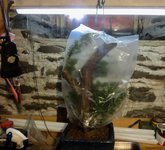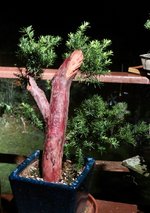@Javaman4373
the normal progression for air layers, you make the ring cut, and remove the bark and cambium, if you are going to use hormones, you dust with hormones, then you pack the wound with sphagnum, or media of choice. THen wrap the bundle up in plastic.
THen WAIT.
THe tree will first form callus. It must form callus before roots will appear. This can take time, sometimes the better part of 12 months. The great news is callus is very winter hardy. It is nearly as hardy as the vegetative parts of the tree are hardy. An air layer that has formed callus can be left on the tree over the winter without causing the air layer to fail.
Often the callus will winter over, and then form roots in early spring. Sometimes the callus will not form roots until the following late summer.
THe speed of air layers taking varies widely.
Ficus and tropicals - can root in 2 or 3 weeks.
Deciduous trees like Elms - can root in 6 to 12 weeks.
Conifers - often conifers do not air layer, but those that do can take 2 to 3 years. Not months, 2 to 3 years.
I have air layered Japanese black pine, several times, and in my Chicago climate roots did not form until the second or third year.
Just keep the air layer moist, give it time, eventually it will root.
I have not personally done Taxus, yew, but I would guess an air layer put in place summer of 2020 would make roots by summer 2021.
Just give your yew time.










